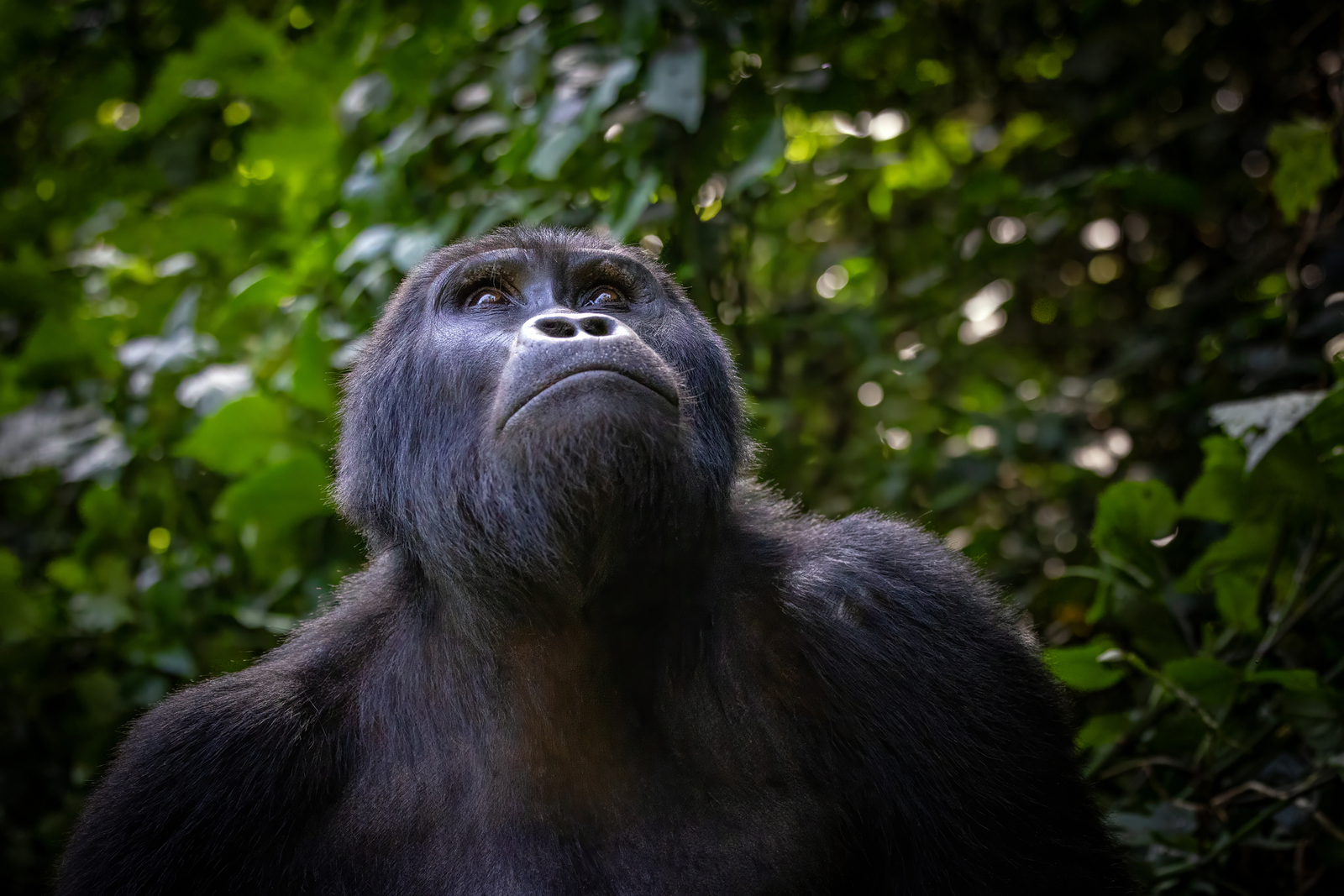Mountain gorillas: One of Africa’s most magnificent and essential species
- Nature Conservation
- Land Conservation
- Iconic Species
- Wildlife
- Mammals
- Equatorial Afrotropics
- Afrotropics Realm
One Earth’s “Species of the Week” series highlights an iconic species that represents the unique biogeography of each of the 185 bioregions of the Earth.
Where the border of the Democratic Republic of the Congo meets and separates into the nations of Rwanda and Burundi, a dense rainforest flourishes, rich with some of the most biologically diverse species on the planet. In this lush jungle is found one of Africa’s most magnificent and essential species. The mountain gorilla (Gorilla beringei beringei) is known as an “umbrella species,” helping protect their habitat and the variety of life that thrives there.

Mountain gorillas (Gorilla beringei beringei) are the iconic species of the Victoria Basin & Albertine Rift Forests bioregion (AT12), located in the Equatorial Afrotropics subrealm of the Afrotropics realm.
A distinct subspecies of eastern gorillas
There are two species of gorillas, the western gorillas and the eastern gorillas. The subspecies of the west include the western lowland gorilla and Cross River gorilla, whereas the east contains the Grauer’s gorilla and the mountain gorilla.
Mountain gorillas are most notable for their fur, which is thicker and longer than that of other gorilla species, which enables them to live in the colder mountain temperatures that often drop below freezing. Despite being smaller than their eastern lowland gorilla cousins, mountain gorillas can grow to astonishing heights. The largest ever recorded was a 1.83 m (6 ft) tall male, weighing 267 kg (589 lb).
Nature’s seed planters and forest pruners
To achieve this massive size, mountain gorillas are diurnal, spending most of the day eating. On average, adult males eat 18.8 kilograms (41 lb) of food a day, while females consume 14.9 kilograms (33 lb).
It is with this diet of leaves, shoots, stems, bark, roots, flowers, and fruit that mountain gorillas help spread and plant seeds across the forest floor with their droppings. Also, with their large body movements and picking of vegetation, they help prune the forest, allowing new seedlings to bloom.

Dominant male mountain gorilla in Bwindi Impenetrable Forest National Park, Uganda. Image Credit:© Andrey Gudkov | Dreamstime.com.
Behavioral insights highlight human's deep connection to Nature
The conservation and study of mountain gorillas provide insight, as their behavior is so akin to humans that it is evidence of our role as a part of nature, not separate. Foraging begins early in the morning as the sun rises, but if it’s cold and overcast, these gorillas often stay longer in their nest, cuddled together. Around midday and then again in the evening, mountain gorillas take time to rest from their daily work to establish and reinforce relationships within their group by grooming and playing.
Vocal communication: The language of gorillas
Twenty-five distinct vocalizations have been recognized by researchers, but a language of grunts, barks, yells, and deep rumblings is clearly known by the gorilla group. Like humans, mountain gorillas also appear to be afraid of certain reptiles and insects, some have also been observed fearing water and storms.

Mountain gorilla mother holding her three-day-old son in her arm, Virunga Mountains, Rwanda. Image Credit: © Erwin F. | Dreamstime.com.
Populations rebound thanks to conservation efforts
Even as mountains gorillas can be identified by nose prints unique to each individual, their likeness to humans doesn’t stop their population numbers from dwindling due to human activity. By the late 1970s, mountain gorillas faced a dire situation, with only 230 individuals remaining due to habitat loss, poaching, and civil unrest.
Conservation efforts, though slow to start, have since proven successful. As of 2018, the mountain gorilla was listed as endangered on the IUCN Red List, with the population now estimated at over 1,000 individuals. In the Virunga region alone, a 26.3% population increase has been recorded since the early 2000s, offering hope for the species’ survival.
The role of Dian Fossey and community-based conservation
The tireless work of conservationists like Dian Fossey has been instrumental in the recovery of the mountain gorilla. Fossey championed active conservation through anti-poaching patrols, strict law enforcement, and habitat protection, while promoting theoretical conservation methods such as ecotourism to generate revenue. Additionally, community-based conservation has played a key role in ensuring local populations benefit from the preservation of gorilla habitats.
Today, ecotourism in countries like Rwanda and Uganda continues to provide the necessary funds for gorilla protection, while fostering a collaborative relationship between conservationists and local communities. This approach has not only safeguarded the gorillas, but also ensured long-term benefits for the people living alongside them.

Adult male mountain gorilla in Uganda. Image Credit: © Rixie | Dreamstime.com.
Ensuring the survival of mountain gorillas
The future of mountain gorillas remains uncertain, but their remarkable recovery offers hope for the species and the ecosystems they support. Continued conservation efforts, alongside community engagement and habitat protection, are essential to ensuring their survival.
These magnificent creatures remind us of our shared responsibility to safeguard nature, preserving not only the mountain gorillas but the delicate balance of life within their forests. By working together, we can protect these endangered giants and the biodiversity of our planet for generations to come.
Support Nature Conservation


%20(1).jpeg?auto=compress%2Cformat&h=600&w=600)

